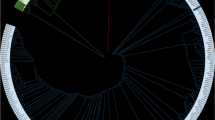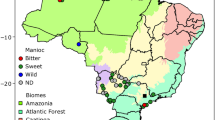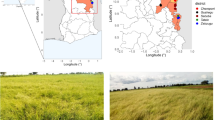Abstract
Taro (Colocasia esculenta) and the greater yam (Dioscorea alata) are staples in Vanuatu. The aim of the present study was to assess the role of somaclonal variations in the varietal diversification of these two clonally propagated crops. The study was conducted in six villages located each on distinct islands of Vanuatu, Melanesia. Overall, 203 varieties of taro and 80 varieties of yam were collected and DArTs were used for analysis. The overall quality of the DArT markers was high for both species. The percentage of polymorphic clones detected on the DArT array was low for taro (3 %) and high (13 %) for yam, with respectively 202 and 499 polymorphic clones. Each variety was characterized by its multilocus genotype based on its DArT presence/absence profile. For taro, the 203 varieties were represented by 126 unique genotypes and 34 distinct multilocus lineages (MLLs). The high number of unique genotypes and the presence of few varieties sharing a clonal origin, generated a high varietal richness index (R = 0.83). For yam, the 80 varieties were represented by seven unique genotypes and 16 MLLs. The low number of unique genotypes and the presence of numerous varieties sharing a clonal origin generated a low varietal richness index (R = 0.26). Possible factors contributing to these contrasting results are discussed. DArT markers provide evidence that somaclonal variants of taro and yam are selected as new varieties. Strategies aiming at strengthening communities’ capacity to adapt to forthcoming changes should consider the introduction of allelic diversity into farmers’ varietal portfolios.




Similar content being viewed by others
References
Abraham K (1998) Occurrence of hexaploid males in Dioscorea alata L. Euphytica 99:5–7
Abraham K, Nair PG (1990) Floral biology and artificial pollination in Dioscorea alata L. Euphytica 48:45–51
Abraham K, Nair PG (1991) Polyploidy and sterility in relation to sex in Dioscorea alata L. (Dioscoreaceae). Genetica 83:93–97
Ahoussou N, Piquepaille P, Touré B (1982) Analyses biométriques concernant la variabilité potentielle, selon la nature de l’organe de multiplication végétative, chez Dioscorea alata L. (cv. Brazo fuerte). In: Miege, Lyonga (eds). Yams, Ignames. Clarendon Press, Oxford, chap. 9, pp. 89–117, 411p
Arnaud-Haond S, Duarte CM, Alberto F, Serrao EA (2007) Standardizing methods to address clonality in population studies. Mol Ecol 16:5115–5139
Balbil PK, Yasuhara D, Sakaguchi K, Iwashina T, Irie K, Shiwachi H, Toyohara H, Fujimaki H (2012) Recurring somaclonal variation as a factor of intra-specific diversity observed in Dioscorea alata L. Trop Agric Dev 56(2):71–79
Barrau J (1958) Subsistence agriculture in Melanesia. Honolulu, Bernice P. Bishop Museum, Bulletin 219, p.111
Blanco J, Pascal L, Ramon L, Vandenbroucke H, Carrière S (2013) Agrobiodiversity performance in contrasting island: environments: the case of shifting cultivation in Vanuatu, Pacific. Agric Ecosyst Environ 174:28–39
Bonnemaison J (1994) The tree and the canoe: history and ethnogeography of Tanna. University of Hawaii Press, Honolulu, 368 p
Boster JS (1985) Selection for perceptual distinctiveness: evidence from Aguaruna cultivars of Manihot esculenta. Econ Bot 39:310–325
Caillon S, Quero-Garcia J, Lescure JP, Lebot V (2006) Nature of taro (Colocasia esculenta (L.) Schott) genetic diversity prevalent in a Pacific Ocean island, Vanua Lava, Vanuatu. Genet Resour Crop Evol 53:1273–1289
Camus P, Lebot V (2010) On-farm assessment of clonal introduction of root crops diversity in Vanuatu, Melanesia. Exp Agric 46(4):541–559
Chaïr H, Cornet D, Deu M, Baco N, Agbangla A, Duval MF, Noyer JL (2010) Impact of farmer selection on yam genetic diversity. Conserv Genet 11(6):2255–2265
Comai L (2000) Genetic and epigenetic interactions in allopolyploid plants. Plant Mol Biol 43:387–399
Coursey DG (1982) Yams. In: Simmonds (ed) Evolution of crop plants. Longman, London
Dorken ME, Eckert CG (2001) Severely reduced sexual reproduction in northern populations of a clonal plant, Decodon verticillatus (Lythraceae). J Ecol 89:339–350
Douhovnikoff V, Dodd RS (2003) Intra-clonal variation and similarity threshold for identification of clones: application to Salix exigua using AFLP molecular markers. Theor Appl Genet 106:1307–1315
Dumont R, Dansi A, Vernier P, Zoundjihékpon J (2006) Biodiversity and domestication of yams in West Africa: traditional practices leading to Dioscorea rotundata Poir. Quae, Cirad-Ipgri, Nancy, France, 95p
Duputié A, David P, Debain C, McKey D (2007) Natural hybridization between a clonally propagated crop, cassava (Manihot esculenta Crantz) and a wild relative in French Guiana. Mol Ecol 16:3025–3038
Egesi CN, Pillay M, Asiedu R, Egunjobi JK (2002) Ploidy analysis in water yam, Dioscorea alata L. germplasm. Euphytica 128:225–230
Elias M, McKey D, Panaud O, Anstett MC, Robert T (2001) Traditional management of cassava morphological and genetic diversity by the Makushi Amerindians (Guyana, South America) perspectives for on-farm conservation of crop genetic resources. Euphytica 20:143–157
Grivet L, Glaszmann JC, D’Hont A (2006). Molecular evidence of sugarcane evolution and domestication. In: Motley, Zerega and Cross (eds.) Darwin’s harvest: new approaches to the origins, evolution and conservation of crops. Columbia University Press, New York, 390p
Heller-Uszynska K, Uszynski G, Huttner E, Evers M, Carlig J, Caig V, Aitken K, Jackson P, Piperidis G, Cox M, Gilmour R, D’Hont A, Butterfield M, Glaszmann JC, Kilian A (2011) Diversity arrays technology effectively reveals DNA polymorphism in a large and complex genome of sugarcane. Mol Breed 28:37–55
IPGRI (1999) Descriptors for Taro (Colocasia esculenta). IPGRI, Rome, 56 pp
IPGRI/IITA (1997) Descriptors for Yam (Dioscorea spp.). IITA, Ibadan, Nigeria/IPGRI, Rome, Italy, 61 pp
Irwin SV, Kaufusi P, Banks K, de la Pena R, Cho JJ (1998) Molecular characterization of taro (Colocasia esculenta) using RAPD markers. Euphytica 99:183–189
Islam I, Kubota AFM, Takagaki C, Kozai T (2002) Sweetpotato growth and yield from plug transplants of different volumes, planted intact or without roots. Crop Sci 42(3):822–826
Ivancic A, Lebot V (2000) Taro (Colocasia esculenta): genetics and breeding. CIRAD, collection Repères, Montpellier, p 194p
Ivancic A, Quero-García J, Lebot V (2004) Genetically controlled branching corms of taro (Colocasia esculenta). N Z J Crop Hortic Sci 32:167–177
Jaccoud D, Peng K, Feinstein D, Kilian A (2001) Diversity arrays: a solid state technology for sequence information independent genotyping. Nucl Acids Res 29:E25
Karamura D, Karamura E, Tushemereirwe W, Rubaihayo P, Markham R (2010) Somatic mutations and their implications to the conservation strategies of the East African highland bananas (Musa spp.). Acta Hortic 879:615–621
Kirch PV (2000) On the road of the winds. An archaeological History of the Pacific Islands before European Contact. Berkeley and Los Angeles. University of California Press, Berkeley, Berkeley, 424p
Kirch PV (2010) How Chiefs Became Kings. Divine Kingship and the Rise of Archaic States in Ancient Hawai’i. University of California Press, Berkeley 288 pp
Kreike CM, van Eck HJ, Lebot V (2004) Genetic diversity of taro, Colocasia esculenta (L.) Schott, in Southeast Asia and the Pacific. Theor Appl Genet 109:761–768
Lasso E (2008) The importance of setting the right genetic distance threshold for identification of clones using amplified fragment length polymorphism: a case study with five species in the tropical plant genus Piper. Mol Ecol Res 8:74–82
Lebot V (1992) Genetic vulnerability of Oceania’s traditional crops. Exp Agric 28(3):309–323
Lebot V (1999) Biomolecular evidence for plant domestication in Sahul. Gen Res Crop Evol 46(6):619–628
Lebot V (2009) The tropical root and tuber crops: cassava, sweet potato, yams and aroids. CABI Crop Production Science in Horticulture, Cambridge, 420 p
Lebot V, Aradhya M (1991) Isozyme variation in taro (Colocasia esculenta (L.) Schott) from Asia and Oceania. Euphytica 56:55–66
Lebot V, Lévesque J (1996) Genetic control of kavalactone chemotypes in Piper methysticum cultivars. Phytochem 43:397–403
Lebot V, Aradhya M, Manshardt R, Meilleur B (1993) Genetic relationships among cultivated bananas and plantains from Asia and the Pacific. Euphytica 67(3):163–175
Lebot V, Meilleur B, Manshardt R (1994) Genetic diversity in Eastern Polynesian cultivated bananas. Pac Sci 48(1):16–31
Lebot V, Trilles B, Noyer JL, Modesto J (1998) Genetic relationships between Dioscorea alata L. cultivars. Genet Resour Crop Evol 45(6):499–509
Lebot V, McKenna D, Johnston E, Zheng QY, McKern D (1999) Morphological, phytochemical, and genetic variation in hawaiian cultivars of Awa (Kava, Piper methysticum, Piperaceae). Econ Bot 53:407–418
Malapa R, Arnau G, Noyer JL, Lebot V (2005) Genetic diversity of the greater yam (Dioscorea alata L.) and relatedness to D. nummularia Lam. and D. transversa Br. As revealed with AFLP markers. Genet Res Crop Evol 52(7):919–929
Meirmans PG, van Tienderen PH (2004) GENOTYPE and GENODIVE: two programs for the analysis of genetic diversity of asexual organisms. Mol Ecol Notes 4(4):792–794
Olhoft PM, Philipps RL (1999) Genetic and epigenetic instability in tissue culture and regenerated progenies. In: Lerner HR (ed) Plant responses to environment stresses: from phytohormones to genome organization. Dekker, New York, pp 111–148
Perrier X, Jacquemoud-Collet J (2006) DARwin software, version 5.0 for Windows. http://darwin.cirad.fr/darwin. Accessed 20 Apr 2014
Perrier X, De Langhe E, Donohue M, Lentfer C, Vrydaghs L, Bakry F, Carreel F, Hippolyte I, Horry JP, Jenny C, Lebot V, Risterucci AM, Tomekpe K, Doutreleponte H, Ball T, Manwaring T, de Maret P, Denham T (2011) Multidisciplinary perspectives on banana (Musa spp.) domestication. PNAS (US) 108(28):11311–11318
Pujol B, David P, McKey D (2005) Microevolution in agricultural environments: how a traditional Amerindian farming practice favours heterozygosity in cassava (Manihot esculenta Crantz, Euphorbiaceae). Ecol Lett 8(2):138–147
Quero-García J, Courtois B, Ivancic A, Letourmy P, Risterucci AM, Noyer JL, Feldmann P, Lebot V (2006) First genetic maps and QTL studies of yield traits of taro (Colocasia esculenta (L.) Schott). Euphytica 151:187–199
Quiros CF, Ortega R, van Raamsdock L, Herrera-Montoya M, Cisneros P, Schmidt E, Brush SB (1992) Increase of potato genetic resources in their centre of genetic diversity: the role of natural outcrossing and selection by the Andean farmer. Genet Resour Crop Evol 39:107–112
Ragone D (1991) Ethnobotany of breadfruit in Polynesia. In: Cox PA, Banack SA (eds) Islands, plants and polynesians: an introduction to polynesian ethnobotany. Dioscorides Press, Portland, Oregon, pp 203–220
Risterucci AM, Hippolyte I, Perrier X et al (2009) Development and assessment of diversity arrays technology for high-throughput DNA analyses in Musa. Theor Appl Genet 119:1093–1103
Roullier C, Kambouo R, Paofa J, McKey D, Lebot V (2012) On the origin of sweet potato (Ipomoea batatas (L.) Lam.) genetic diversity in New Guinea, a secondary centre of diversity. Heredity 110(6):594–604
Saitou N, Nei M (1987) The neighbor-joining method: a new method for reconstructing phylogenetics trees. Mol Biol Evol 4(4):406–425
Sardos J, Rodier-Goud M, Dambier D, Malapa R, Noyer JL, Lebot V (2009) Evidence for spontaneous polyploidization in cassava Manihot esculenta Crantz. Plant Syst Evol 283(3–4):203–209
Sardos J, Noyer JL, Malapa R, Bouchet S, Lebot V (2012) Genetic diversity of taro (Colocasia esculenta (L.) Schott) in vanuatu (oceania): an appraisal of the distribution of allelic diversity (dad) with ssr markers. Genet Resour Crop Evol 59(5):805–820
Scarcelli N, Tostain S, Vigouroux Y, Agbangla C, Dainou O, Pham JL (2006) Farmers’ use of wild relative and sexual reproduction in a vegetatively propagated crop: the case of yam in Benin. Mol Ecol 15(9):2421–2431
Scarcelli N, Tostain S, Vigouroux Y, Luong V, Baco MN, Agbangla C, Daïnou O, Pham JL (2011) Genetic structure of farmer-managed varieties in clonally-propagated crops. Genetica 139:1055–1064
Schwaergle KE, McIntyre H, Swingley C (2000) Quantitative genetics and the persistence of environmental effects in clonally propagated organisms. Evolution 54:452–461
Seelenfreund D, Pina R, KY Ho, Lobos S, Moncada X, Seelenfreund A (2011) Molecular analysis of Broussonetia papyrifera (L.) Vent. (Magnoliophyta: Urticales) from the Pacific, based on ribosomal sequences of nuclear DNA. NZ J Bot 49(3):413–420
Sokal RR, Michener CD (1958) A statistical method for evaluating systematic relationships. Univ Kansa 38–2(22):30p
Valladares F, Gianolli E, Gomez JW (2007) Ecological limits to plant phenotypic plasticity. New Physiol 176(4):749–763
Walter A, Lebot V (2007) Gardens of Oceania. ACIAR Monograph No. 122. Canberra, Australia, 326 pp
Wenzl P, Carling J, Kudrna D, Jaccoud D, Huttner E, Kleinhofs A, Kilian A (2004) Diversity arrays technology (dart) for whole-genome profiling of barley. PNAS 101:9915–9920
Zerega NJC, Ragone D, Motley TJ (2004) Complex origins of breadfruit (Artocarpus altilis, Moraceae): implications for human migrations in Oceania. Am J Bot 91(5):760–766
Acknowledgments
This research was financially supported by the French ANR SYSTERRA Project No ANR-10-STRA-007. We would like to thank Corinne Bulé and Floriane Lawac for technical assistance and morphological description of germplasm at VARTC. Our deepest gratitude goes to farmers who took the time to explain the differences between their varieties.
Author information
Authors and Affiliations
Corresponding author
Rights and permissions
About this article
Cite this article
Vandenbroucke, H., Mournet, P., Vignes, H. et al. Somaclonal variants of taro (Colocasia esculenta Schott) and yam (Dioscorea alata L.) are incorporated into farmers’ varietal portfolios in Vanuatu. Genet Resour Crop Evol 63, 495–511 (2016). https://doi.org/10.1007/s10722-015-0267-x
Received:
Accepted:
Published:
Issue Date:
DOI: https://doi.org/10.1007/s10722-015-0267-x




